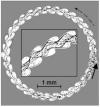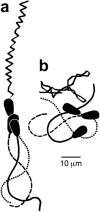Mammalian sperm interactions with the female reproductive tract
- PMID: 26183721
- PMCID: PMC4703433
- DOI: 10.1007/s00441-015-2244-2
Mammalian sperm interactions with the female reproductive tract
Abstract
The mammalian female reproductive tract interacts with sperm in various ways in order to facilitate sperm migration to the egg while impeding migrations of pathogens into the tract, to keep sperm alive during the time between mating and ovulation, and to select the fittest sperm for fertilization. The two main types of interactions are physical and molecular. Physical interactions include the swimming responses of sperm to the microarchitecture of walls, to fluid flows, and to fluid viscoelasticity. When sperm encounter walls, they have a strong tendency to remain swimming along them. Sperm will also orient their swimming into gentle fluid flows. The female tract seems to use these tendencies of sperm to guide them to the site of fertilization. When sperm hyperactivate, they are better able to penetrate highly viscoelastic media, such as the cumulus matrix surrounding eggs. Molecular interactions include communications of sperm surface molecules with receptors on the epithelial lining of the tract. There is evidence that specific sperm surface molecules are required to enable sperm to pass through the uterotubal junction into the oviduct. When sperm reach the oviduct, most bind to the oviductal epithelium. This interaction holds sperm in a storage reservoir until ovulation and serves to maintain the fertilization competence of stored sperm. When sperm are released from the reservoir, they detach from and re-attach to the epithelium repeatedly while ascending to the site of fertilization. We are only beginning to understand the communications that may pass between sperm and epithelium during these interactions.
Keywords: Cervix; Fallopian tubes; Microfluidics; Oviduct; Spermatozoa.
Figures





References
-
- Baker RD, Degen AA. Transport of live and dead boar spermatozoa within the reproductive tract of gilts. J Reprod Fertil. 1972;28(3):369–377. - PubMed
-
- Chian RC, Sirard MA. Fertilizing ability of bovine spermatozoa cocultured with oviduct epithelial cells. Biol Reprod. 1995;52(1):156–162. - PubMed
-
- Day BN, Polge C. Effects of progesterone on fertilization and egg transport in the pig. J Reprod Fertil. 1968;17(1):227–230. - PubMed
-
- DeMott RP, Suarez SS. Hyperactivated sperm progress in the mouse oviduct. Biol Reprod. 1992;46(5):779–785. - PubMed
Publication types
MeSH terms
Grants and funding
LinkOut - more resources
Full Text Sources
Other Literature Sources

